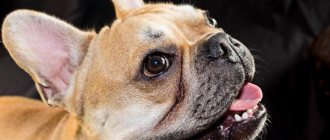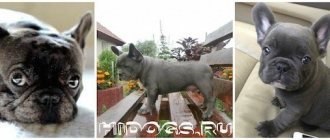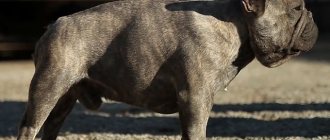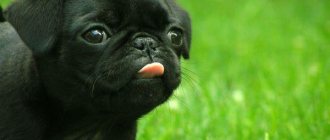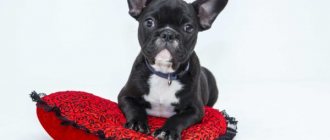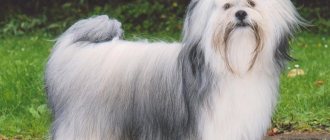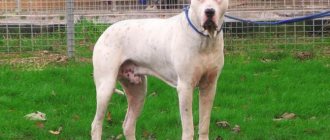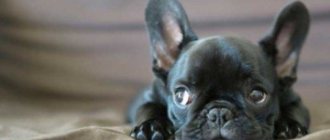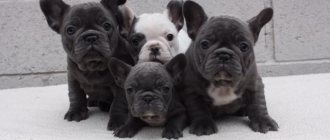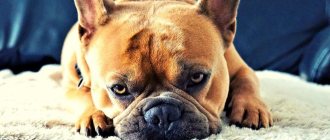Brief characteristics of the breed
Bulldogs were originally fearsome animals.
They were used for guarding, protection, baiting wild animals, fighting with bulls and other dogs. The purpose of the dogs is already clear from the name: it is formed from two words “bull” - bull, and “dog” - dog. They began to change the breed in the 19th century, when brutal bloody battles were banned. Aggression and fighting qualities became unimportant. Friendliness, ability to adapt, and patience came to the fore. Today, boules are companions first and protectors second.
All bulldog breeds have a common appearance feature - a shortened muzzle with a flattened nose and skin folds, the so-called. brachycephalic head. They also snore and are prone to obesity and allergies.
The Magnificent Three: Modern Views
There are 3 varieties of the breed approved by the FCI - English, American and French.
English
All types of bulldogs originated from the English variety of the breed. This is a dog whose weight reaches 25 kg, and the height at the withers is 40 cm. The color is varied: brindle, red, brown or red with white spots.
The ancestors of the English Bull came to Europe along with nomadic peoples. They were valued for their ferocity: the dogs were used for roundups and bull baiting. The dogs grabbed the animals' faces and strangled them.
Today the English Bulldog is a calm, balanced dog, somewhat lazy and stubborn. She is devoted to her family and indifferent to strangers. However, the military past has not disappeared without a trace - in case of danger, pets will defend themselves and their owners.
English bulldogs are suitable for all families - from singles to large families. But they need attention and regular examination by a veterinarian. The breed is prone to diseases of the skin, heart, and musculoskeletal system.
We'll have to tinker with our upbringing as well. The British are capricious and do not remember commands well. Even if they understood the order, the dogs will think three times before obeying.
American
The American Bulldog is the closest relative of the English Bulldog. It was brought to the United States by immigrants from Great Britain in the early 18th century.
In America, the breed was used in battles, for herding, guarding and hunting large animals. So that the dogs could cope with such complex responsibilities, large puppies were chosen. The rest were discarded.
The result was a strong and resilient dog. The American variety reaches 70 cm at the withers and weighs up to 58 kg.
Americans are more similar than other varieties to their ancestors - the Old English Bulldogs. However, the breed almost disappeared. At the beginning of the 20th century, only a few representatives remained. John Johnson began breeding dogs, and by the 1980s the population was restored.
Due to long-term selection, the breed was divided into 2 types:
- Classic or Johnson type. A large dog with a short muzzle, developed guarding and protective skills.
- Standard or Scott type. Less of the classic look, but more durable and athletically built. Suitable for hunting and livestock work.
Cynologists note the appearance of a mixed type. Breeders produce a versatile dog with the qualities of the standard and classic American Bulldog.
Americans are loyal, strong and formidable companions. The standard states “protection of the owner in all situations, even at the cost of life.” Dogs are aggressive and perceive strangers as a potential threat. They need a firm hand, otherwise the dogs will grow uncontrollable. Therefore, it is not recommended for beginners to have pets.
A distinctive feature of the American Bull is the absence of folds on the puppies' muzzle. They appear as they grow older.
French
The most good-natured of all bulldogs is the French one. He was bred as a decorative dog that would love children, get along with other pets and brighten up the evenings of lonely people.
The bulldog was brought to France by immigrants from England - weavers, tailors, shoemakers. They moved in 1848 - 1860. during the crisis in Great Britain. The workers took small representatives of the breed, because... they were easier to transport and maintain.
At first, the French Bulldog breed was classified as a small fighting dog. Later they began to keep him as a companion and for exterminating rodents. The dogs were crossed with local dogs - pugs and terriers.
The result is a small dog weighing up to 15 kg and 30 cm tall. He has a funny appearance: a flattened muzzle with bulging eyes and erect ears like a bat.
French bulldogs are loving and sociable pets. They have no aggression, they are equally happy with their owners and guests, and love to play with children and pets.
The breed is the sickest among all boules. They are leaders in allergies, cardiovascular pathologies, and joint diseases. In addition, mating is difficult due to the wide and low-set paws, and childbirth in a French bulldog is difficult; bitches often undergo a caesarean section.
The main varieties of bulldogs, with descriptions and photos, are presented above. However, there are still little-known and unrecognized species of the breed.
French Bulldog: breed standard
French bulldogs are smaller than their English counterparts. Weight varies between 10-15 kg. Height at withers is from 25 to 30 cm.
Males are more massive than females, although both have prominent muscles, “stretched” over a powerful frame.
The muzzle is short with an eye-catching forked nose and the same forked upper lip.
The jaws are strong, square, with strong and healthy teeth. Bite – snack. The lower jaw protrudes slightly forward.
Photo 1. French bulldog loves companionship at home
The upper and lower lips should be completely closed, completely hiding the teeth. The muscles on the cheeks are well developed.
The eyes of French Bulldogs are set low, away from the ears and nose, and have a lively expression.
The ears are large and rounded at the tips. The ears are directed forward.
The back and loin are short and muscular. The croup is sloping. The chest resembles a barrel. The ribs are wide and rounded.
The tail is short and thick at the base.
The forelimbs are distinguished by prominent muscles. The shoulders, forearms, and wrists of the forelimbs are harmoniously linked with each other and create the impression of a knocked down and “pumped up” animal with a fighting character.
The same can be said about the hind limbs.
The French Bulldog's coat is short, dense, thick and smooth. There is no undercoat.
The color can be quite varied: various shades of fawn, brindle, white, white and brindle and black and brindle.
Prohibited colors include “mouse” (blue-gray), chocolate, fawn with a blue mask, merle, tricolor. Their presence is grounds for disqualifying the dog.
Rare bulldogs
The breed is not limited to just three varieties. There are other types of bulldogs, photos and characteristics of which can be found below.
Old English
The progenitor of bulldogs, from which other types of breeds originate. It was used for bull baiting and fighting.
Today there are no original representatives left. They disappeared. The American David Levit started reviving the Old English boules in 1971. He crossed an English and an American bulldog, an American pit bull terrier and a bullmastiff. As a result, the breeder received a breed that is as similar as possible to its ancestors.
The modern Old English Bulldog is less aggressive than its ancestors. Families can have a dog. However, the owner must be an experienced dog handler, and the pet should not be left alone with children.
The dog is medium-sized: weight up to 36 kg, and height up to 51 cm. However, it is powerful, muscular, with a difficult character. The Old English are stubborn, headstrong, and need a firm hand and daily exercise. Therefore, pets are not suitable for beginners.
Continental
The continental variety originated in Switzerland. In her veins flows the blood of the modern type of Old English and English Boule.
FCI was involved in breeding the breed. However, she subsequently refused to recognize her. To legitimize the status of the continental, Swiss dog breeders established the Club of Fanciers in 2004.
The Continental Bulldog has 2 key differences from its ancestors:
- Suit. Red, brown or a combination of both colors, a black mask is desirable.
- Character. Despite their 30 kg muscle mass, the dogs are flexible, friendly, and get along with children and pets. Dogs are easy to train - they are attentive and try to please people. A huge plus is non-aggression. Continental boules become angry only when there is danger.
Alapaha
The Alapaha Bulldog was bred from English. It appeared at the beginning of the 20th century.
The first stud dog, Otto, was owned by Buck Lane. After his death, the pet guarded his owner’s grave every day. Further breeding was continued by Lane's granddaughter. She got the breed recognized by the Organization for Animal Scientific Research.
Other canine organizations do not recognize the Alapaha. This is a rare breed; there are up to one hundred and fifty representatives in the world.
The Alapah is an outwardly calm but strong, courageous and aggressive dog, similar to the American breed. It is better to keep her in a private house behind a fence, but not in an enclosure. The breed is extremely loyal and protects the owner in any dangerous situation, even imaginary ones.
The Alapaha has 45 kg of muscle without a gram of fat, and at the withers it reaches 66 cm. The coat is hard, short, and lies close to the body. Color black, white or shades of merle, red and brown. You can get an accurate idea of the appearance if you look at the photographs.
Alano
Alano is an ancient dog, whose ancestors were brought to the lands of Spain by nomads. According to the country of origin of the dogs, a second name is also used - “Spanish bulldog”.
Important features and content rules
Buying a French bulldog should not be spontaneous - just like any other dog. It is necessary to find out in advance as much as possible about the breed you like, its pros and cons, and maintenance features. After this, it will become clear: are you ready to have just such a pet or should you find someone more problem-free.
Don't believe all the bad things they say about me, I'm a wonderful dog
It’s precisely the French who cannot be called problem-free. With all the visible advantages of the breed, it has quite a few difficulties that you need to be willing and able to cope with:
- they often get sick - unsystematic breeding has aggravated breed diseases, especially those related to the bones, respiratory and cardiovascular systems;
- they can be allergic - first of all, this applies to dogs of pure white color, whose immunity is often weaker than that of other French dogs;
- they are not decorations - these small dogs remain true Molossers, they need attention and walking, the cat litter box can become a real insult for them;
- they slobber, snore and spoil the air - nothing can be done, these are also breed characteristics that you can easily come to terms with if you really love a dog;
- they are not as easy to care for as they might seem - bulldogs shed very actively, and short, sharp hairs stick tightly into clothes and upholstered furniture;
- they are difficult to breed - even standard bitches often give birth only by caesarean section, let alone the dwarf varieties of the breed;
- they have a difficult character - if you don’t educate a Frenchman, he will definitely sit on your head, showing miracles of stubbornness, arrogance and domestic tyranny.
To all that has been said above, we can also add that there are quite a lot of cases of serious bites by ill-mannered Frenchmen of people and even their own owners. Have you changed your mind about buying this cutie yet?
The French bulldog may well have a festival of disobedience
Don't get bulldogs! Do not get one if this is your first time encountering this breed and you know it only from photographs, if you are not confident in yourself that you can cope with raising this dog. Why does this funny pig have the constitution of a fighting dog? But because that's what she is. Bulldog is a fighter by birth. If you take a bulldog as a fun decoration “for the sofa,” remember that you risk raising a willful dictator who will take power “into his own paws.” And you can't do anything about it. Because they are simply not ready for this.
manasmult
https://wap.frenchbulldog.borda.ru/?1–8-0–00000022–000–10001–0
Historical reference
The general history of this group of dogs can be traced back centuries to the Molossian Dogs, fighting dogs that belonged to the noble Greek family of Molossi in ancient Athens. Indeed, the English bulldog is considered a participant in an unattractive sport - bull baiting: the dog grabbed the nose of the bull and did not let go until it fell down.
After the ban on such cruel entertainment in 1835, a transformation took place in the use and education of the breed. The Bulldog becomes more of a companion than a formidable beast. However, the charisma of appearance and genetics are reminiscent of times when cruelty and a stranglehold were valued.
All bulldogs have a common feature: a slightly flattened muzzle with folds (bull). The name “bulldog” itself is translated from English as “bull dog”. These are natures with well-developed intellect, they are stubborn, patient, and friendly towards other pets. All varieties of bulldog breeds are ready to stand up for themselves - this is due to their fighting past.
Features of feeding and diet
The best option for bulldogs with sensitive digestion is super premium dry food. It includes the vitamin and mineral complex that your pet needs. Before choosing food, you need to consult with an experienced breeder, or better yet, a veterinarian. Perhaps not right away, but you will find the ideal product for your pet.
The possibility of natural feeding is not excluded. But here you will have to carefully work on creating a menu. Of course, every dog has individual preferences, but there are some general recommendations for feeding an English Bulldog
:
- The diet should be balanced, so you should not feed the dog only meat - add vegetables and cereals.
- Bones do not provide any nutritional value, so they should be excluded from the diet.
- Any fatty food has a detrimental effect on the pancreas and liver; it is better to stick to lean poultry or beef.
- Food from your table is not a treat for your dog. Don't let children feed it to your dog, and don't give it human food yourself.
Up to 4 months, a puppy should be fed 5-6 times a day, reducing this figure to 3-4 times by six months. By nine months, the number of feedings decreases to 2-3 times a day. It is enough to feed an adult dog 2 times a day: morning and evening.
Avoid overfeeding the puppy and adult. This may have a detrimental effect on your future health.
Feeding should be at regular intervals. Discipline exists in everything, even in food.
The puppy is not fed at night - he must get used to the routine and be content with sleep. The first feeding can be no earlier than 7 am, and the last - no later than 23.00.
You should not give:
- raw, river fish;
- pork;
- raw eggs;
- legumes (peas, beans);
- fresh bread;
- tubular bones;
- ground meat.
Water for a dog, like for a person, should always be clean and fresh. If you suddenly have doubts about the quality of water, you should boil it. When getting ready for a trip, don’t forget to make sure your dog has something to drink. It is not recommended to drink from a puddle, ditch, or river on the street - this is fraught with infection by parasites, leptospirosis and other terrible diseases.
Modern trio: photos of varieties of bulldog breeds
Popular types of modern bulldogs are American, English and French. A representative of the New World opens a gallery with photos of varieties of bulldog breeds .
American
The breed is unique, a relative of the old English bulldogs. Bred to guard and hunt. Height 50-70 cm, weight up to 58 kg.
Currently, there are two types of this breed:
- Classic (Jackson type). She has a developed guardian instinct.
- Standard (Scott type). These Americans are used for hunting.
The American Bulldog is a leader. He does not tolerate competition, the dog is formidable, but devoted to the family. He loves children and will play with them with pleasure, but they must treat him with respect. When getting a pet like this, you need to have a strong character in order to be able to rein in the dominant animal.
Puppies greet strangers with distrust and hostility. From the very first days they must be taught to calmly perceive strangers. When the puppy grows up, he will be able to evaluate people’s behavior and distinguish those who are negative.
Important! The standard of this breed states: “protection of the owner in any situation, even at the cost of one’s own life.”
American's problems:
- Allergy. This may occur on some products; you should definitely check with the breeder. You may need to use antihistamines.
- Dysplasia of the hip and elbow joints. This problem is serious, even requiring surgical intervention. Detection of the disease is possible only through computer diagnostics.
English
Bulldog breeds – photos with names cannot be imagined without the “English gentleman”. It is from him that all other bulldogs are formed. Unperturbed, calm, slightly lazy. It's not easy to train him. One of the traits of the breed is stubbornness (i.e. I understand the command well, but I am not sure that I will carry it out). But if there really is a threat of danger, then determination and speed of reaction immediately manifest themselves.
Height 40-50 cm, weight up to 25 kg. It has short hair and care for its claws and claws is simple, but it must be done regularly. Be sure to use a damp cloth or disc to wipe the folds on the face. On hot days, perform this procedure daily.
Attention! It is necessary to wipe the area near the tail so that germs do not collect on the skin (it can be strongly pressed and deformed).
An English Bulldog should not be overfed, as the dog is prone to obesity.
Problems of the English Bulldog:
- Short airways. The consequence is susceptibility to colds. They do not like overheating, hot weather is contraindicated for them - they begin to breathe hoarsely, viscous mucus forms, and there may be swelling of the larynx.
- Fast fatiguability. According to the anatomy of this animal, the entire load goes not on the muscles, but on the bones. The dog eats a lot and moves little, which leads to obesity. The result is fatigue and shortness of breath.
Important! Most puppies are born by caesarean section (their heads are too big).
English Bulldogs are ranked among the most popular in the world; they have a calm disposition and are well suited to singles and the elderly. A dog has a wonderful quality - the ability to listen.
The Bulldog needs daily exercise, but is heavy and does not like to be very active . Therefore, a leisurely walk in the park with an elderly owner will be beneficial for him. Dogs are patient and great with children.
French
The varieties of bulldogs are decorated with a decorative breed from France. Main advantages: good nature and devotion, as well as a perky character. This dog has amazing bulging eyes and large erect ears. The muzzle is square and massive. Height 30 cm, weight up to 14 kg. Despite its small size, in case of danger it will fight for its owner to the end.
French Bulldog Problems:
- third eyelid disease (requires surgery);
- allergies (dermatitis, scratching);
- heavy snoring.
This breed has many positive aspects:
- barks a little;
- loves children;
- does not take up much space in the apartment;
- friendly to strangers.
Attention! Teeth require brushing every week, and warm clothing will be required during the cold season.
The Frenchie is not aggressive, playful, there is no shedding or unpleasant odor. Therefore, families with children are happy to purchase such pets. Walks in the air are definitely needed, but not for long in winter, she has poor heat exchange.
Features of keeping a French bulldog
The dog was literally born to be kept in a city apartment. Minimal comfort and a few short daily walks are enough.
Constant human contact is vital for French Bulldogs.
Photo 3. The French bulldog is unpretentious in food, but demanding in communication
These dogs don't eat much. A balanced diet eliminates any allergic reactions. The French Bulldog's diet is standard, typical for small dog breeds.
It is advisable to use premium and super-premium dry food, and also provide your pet with round-the-clock access to drinking water.
Due to the lack of undercoat and short hair, French bulldogs do not tolerate cold weather well (especially with infrequent walks and low mobility).
Because of this, drafts and walks in severe frosts are contraindicated for them. Keeping such animals in enclosures is also unacceptable.
When walking in winter, it is advisable to use special overalls that protect the dog from hypothermia.
As part of hygiene procedures, it is recommended to brush your dog daily and monitor the condition of the folds on the face, ears and areas in the eye area.
About the history of the breed
The name of the breed group comes from the English “bulldog”, which means “bull dog”.
This name is a tribute to the past of these dogs, when they were used as baiting dogs. Bulldogs were released against bulls, bears, lions and other large animals. The main goal of such a competition for dogs was to capture the animal and hold it until it completely fell.
After the ban on such entertainment in the 19th century. dogs began to be used as a fighter in the arena against each other and representatives of other breeds.
By 1859, such entertainment was also banned, and the direction of selection shifted towards the eradication of aggressiveness and anger. Such dogs began to be used as companions.
Common features for all representatives of the group are:
- Powerful body with good muscles;
- Large round head with a flattened muzzle;
- Squat build;
- The presence of folds on the body and head.
Many breeds from this group are small in number or are on the verge of extinction. The reduction in the number of animals and the decline in popularity began with the ban on the participation of dogs in fights with other animals.
Alano
The breed is also known as the Spanish Bulldog, Alano Espanol and Spanish Alano . One of the oldest breeds of the group, presumably bred by the Assyrians, the first mentions date back to the 12th century. BC. The dogs are descendants of Molossians; the hypothesis about the presence of a Tibetan Great Dane in their ancestors is also accepted.
The name of the breed, according to one version, is translated as “bulldog”; according to another, it is given in honor of the “Alans” people, whose representatives bred the first dogs of this type. They were used to participate in battles, hunting, herding livestock, guarding, and pursuing Indians. Interest in Alanos fell after the ban on bloody competitions; at the moment, there are very few representatives of the species.
The breed is not recognized by the FCI, but is registered with the country's national kennel club. The standard requirements establish the following dimensions for dogs:
- Males - 60-65 cm at the withers, 38-45 kg in weight;
- Females are 56-61 cm in height, weight 33-38 kg.
The Alan has a large, rough head with a voluminous forehead and a rounded skull. muzzle is shortened, wide, and rounded towards the chin. The jaws are powerful, with a slight bite. The eyes are medium in size, from amber to brown in tone. Ears are often cropped, although a natural option is acceptable.
body is slightly elongated, with a powerful muscular back, tucked belly and deep chest. The skin forms a dewlap

